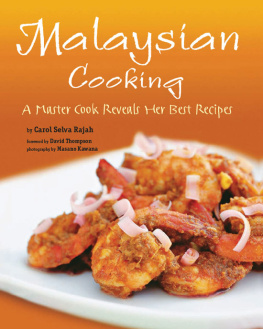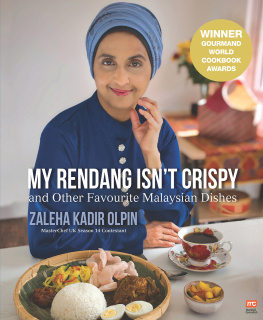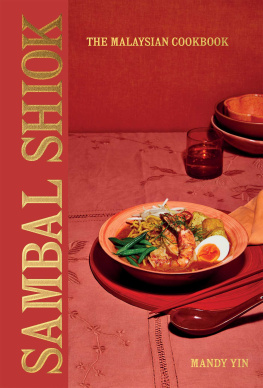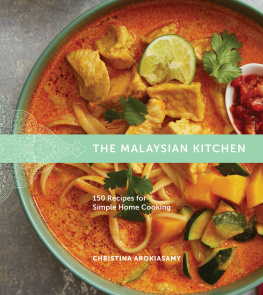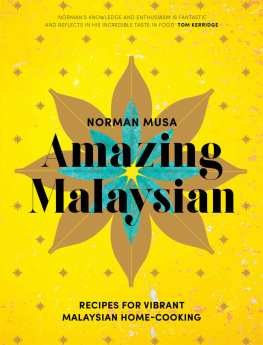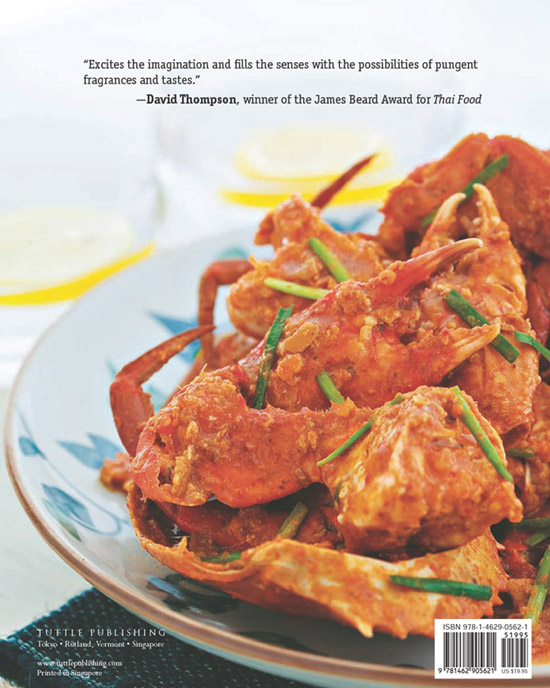Tapping Into Delicious Memories

I have been fortunate enough to have eaten Carols food many times, sometimes with Carol sitting next to me telling me the most marvellous tales of her family, her Amah and her childhood in Malaysia. I sat mesmerised as she wound her stories around her fooduntil I was not sure which was the more alluring. But I was always left wanting more, and I was not alone in this as I know many who have been held in the same thrall of her charm and her cooking.
We cooked for pleasure, she told me. We forgot which community we belonged to and we cooked to feed and to please our friendswhether they were Malays, Chinese, Tamils, or later Australians. And such hospitable charm fills this book.
Malaysian Cooking is an account of these stories and their dishesa dance through her childhood, tapping into delicious memories with the steady, rhythmic clunk of the granite pestle pounding the spices and filling our senses with the pungent aromas that still hold such a powerful sway over her and her cooking. The garden of her youth was filled with lemongrass, galangal, roseapples and durians. Her Amahs Aromatic Chicken Curry skips straight out of her rich, happy past. I can imagine it served with Fragrant Pandanus Coconut Rice (Nasi Lemak), or on special occasions with Lacy Malay Coconut Pancakes (Roti Jala). Flaked fish salad with spices and coconut was a dish which her husband, Selva, insisted on preparing himself to ensure the proper seasoning, while her lethal weapon of Babi Tayu (Tau Yew Bak)Sweet Soy Pork with Mushrooms and Star Anisepacks an Amahs love!
This book is not just based in the vivid but somewhat distant past. It is a collection of the authors memories throughout her lifeand it contains many recipes that are not just Malaysian. They are her own authentic recipes reflecting her lifes journey.
Malaysian Cooking evokes more than just memoriesit excites the imagination and fills the senses with the possibilities of pungent fragrances and tastes that create new memories. It articulates the past and present of a talented cook in the very best waywith wonderfully delicious recipes!

Acknowledgements
This book has been slow-cooking for a long time like any good dish, with spice and herb. Starting as a book on the aromatics of Malaysian food, it contained traditional recipes with a working title we called Ginger Flower.
My daughter Anushiya Selvarajah, a trained teacher of Asian cooking for over 10 years, assisted by Patricia Soosay from Perth, who wanted to gain more of an understanding of Malaysian cooking, tested recipes for months. Both girls knew the food and understood the cuisine just as much as I did, yet we found ourselves re-testing, changing and sometimes reverting to our original recipes in an attempt to improve and to simplify techniques. Finally without any murders or mayhem, the recipes were collated and I thank both Patricia and Anushiya sincerely for teasing out the best flavours with dedication and care.
Thanks also go to Matt Lim and to Diane Temple for her careful recipe formatting. The help and friendship of Philippa Sandall, Andrea Rademan and Wendy Lloyd Jones have, as always, been invaluable.
I include some recipes from friends whose work I admire: Lyndey Milan and Di Holuigue, Pauline Loh, Patricia Soosay, Simon Goh and Marty Morrison. I would also like to thank Michelle Sandhu, my niece in Singapore, my brother Abel Arumugam and his wife Gomathy, and Andrea Rademan in Beverly Hills, California, for the use of their kitchens and their computers while working abroad and for their generosity, to Christina Ong for her creative eye and food-styling that has guided the books tone and atmosphere and to Masano for his photography. Thanks also to Dr. Max Lake, OAM.FRCS, International wine judge and author of six books on flavour, taste and aroma. I would not have dared to venture into this realm had I not been convinced of Maxs support and critique; to dear friends Cheong Liew for his support and David Thompson for writing the foreword.
And to Ben Cardillo, for allowing me to see my Malaysia through his eyes, when, in 1991, he wished we had smell-a-vision while we were filming for a television series in Kuala Lumpur. The following books were used as references:
Spice Notes by Ian Hemphill
Dictionary of Japanese Foods by Richard Hosking
The Chinese Kitchen by Deh-Ta Hsuing
Thai Food by David Thompson
Taste by Max Lake
Sense and Sensuality by Max Lake
Tropical Planting and Gardening by H.E.
Holtum and Macmillan, revised by Barlow Enoch and Russel
DEDICATION
Aromas have seldom been explored for themselves except by vintners, sommeliers and perfumers, although they are recognised as an integral part of flavour. A Malaysian housewife prides herself on food that is wangi or ho heong, as my Amah used to say. Aromas intrigue when they are combined carefully into a fragrance that is difficult to analyse and yet at the edge of your senses, as they bypass the cognitive brain, going directly to the emotive. So enjoy aromas in food by breathing deeply and sitting down to eat, as you use all your senses for a complete experience.
To my family and many friends who have perfumed my life, this book is for youwith love.
SAMBALS, CHUTNEYS, SPICE PASTES AND ACHARS
Chilli sambal
This is a favourite recipe that can be made up and heated for use later and will make a great Christmas gift when bottled.
2 tablespoons oil
4 cloves garlic, crushed
1 medium onion, chopped
1 tablespoons Sambal Oelek Chilli Paste (recipe on this page) or other sweet chilli paste
60 g ( cup) dried prawns, rinsed and dry-roasted
1 tablespoon tamarind pulp, mashed in cup (60 ml) water and strained to obtain the juice
50 g ( cup) dark brown sugar or shaved palm sugar
1 tablespoon fish sauce
Salt, to taste
Heat the oil in a skillet and saut the garlic, onion and Sambal Oelek over medium heat until fragrant,
12 minutes. Add all the other ingredients, except the salt, and saut until the volume reduces to half,
35 minutes. Season with salt to taste and remove from the heat. Cool and store refrigerated in a sealed jar.
MAKES: 1 cup PREPARATION: 20 mins COOKING: 10 mins

Sambal oelek chilli paste
The action of grinding a chilli paste is oelek or ulek in Malay. Commercial brands like the Indonesian ABC brand are good, but this sauce is so simple to make that you should try it. If you have a blender it becomes a simple process, but remember to bring it to the boiling point and cool before storing.
1 onion, peeled and sliced
5 cloves garlic, peeled
2.5 cm (1 in) fresh ginger, peeled and thinly sliced
12 red finger-length chillies, halved and deseeded
2 tablespoons oil
1 teaspoon shaved palm sugar or dark brown sugar
3/8 cup (100 ml) vinegar
teaspoon salt, to taste
Grind the onion, garlic, ginger and chillies in a food processor or mortar to a smooth paste. Heat the oil in a skillet and saut the ground paste over medium heat until fragrant, 35 minutes, seasoning with the sugar, vinegar and salt.

